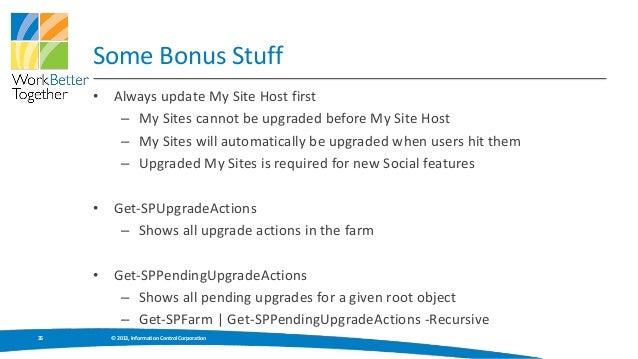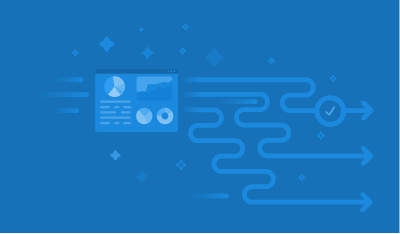-->
To verify the upgrade status of the SharePoint Farm and servers in the farm, open the Central Administration, and in the Upgrade and Migration section, click Check upgrade status. This page will provide information about the servers needing upgrades. Run SharePoint Product Configuration Wizard on the identified servers to complete the patching.
- This time, my gut feeling says I will definitely be using this new upgrade solution for SharePoint 2013. SharePoint 2013 actually installs the files for SharePoint 2010 when it is installed. Features, site templates, site definitions, and Web Parts; The directories on the file system are duplicated in both the 14 and 15 paths, for example.
- The Upgrade-SPContentDatabase cmdlet initiates an upgrade of an existing content database that is attached to the current farm. This cmdlet begins a new upgrade session, which can be used either to resume a failed version-to-version or build-to-build upgrade of a content database or to begin a build-to-build upgrade of a content database.
APPLIES TO: 2013 2016 2019 SharePoint in Microsoft 365

Overview

Overview
The upgrade scenario has not changed in SharePoint Server 2019. There is no direct upgrade path from 2013 to 2019. To upgrade to SharePoint Server 2019, you must upgrade SharePoint 2013 to SharePoint Server 2016, and then upgrade to SharePoint Server 2019. Your databases must be at a SharePoint Server 2016 RTM version or higher when you upgrade to SharePoint Server 2019. Any database with a lower version will be locked and upgrade will not start.
For a visual look of the high-level steps, see
| File Type | Download Location |
|---|---|
| Visio | Upgrade from SharePoint 2013 to SharePoint Server 2019 |
| Upgrade from SharePoint 2013 to SharePoint Server 2019 |
Note
The steps for creating and restoring service applications only applies to these six:
• Secure Store service application
• Business Data Connectivity service application
• Managed Metadata service application
• PerformancePoint Services service application
• User Profile service application
• Search service application
For the specific, end to end steps to upgrade SharePoint 2013 to SharePoint Server 2016, see Upgrade to SharePoint Server 2016
Steps to Upgrade
2013
In SharePoint 2013, if you have any web applications that are in windows authentication mode, you should convert them to claims authentication. Claims authentication is the default mode in SharePoint Server 2016 and SharePoint Server 2019.
Next, upgrade all the site collections from 14 mode to 15 mode by using the Upgrade-SPSite cmdlet. Any database with a 14 version will be locked and prevented from upgrading to SharePoint Server 2016. After the site collections have been upgraded, create a backup of all content and service application databases from your old farm (for example, SQL2013). Restore these databases to a new farm's SQL Server in SharePoint Server 2016 (for example, SQL2016).
2016
In SharePoint Server 2016, build a new temporary farm that includes service applications. When the service applications are created use the existing database names that reside on SQL2016. After the new farm is created, create a new web application with a temporary database. Install any full trust solutions, administrator approved InfoPath forms, etc. Dismount the temporary content database from the web application.
Note
You may need to delete the temporary content database from the SQL Server.
Sharepoint 2013 Upgrade Required Servers In Farm
Start the upgrade process to SharePoint Server 2016 by running the Mount-SPContentDatabase cmdlet on the restored content databases from SQL2016. After the upgrade process is complete, perform any individual configuration changes that are not part of the service application and content databases, such as incoming/outgoing email settings, etc.
2019
The steps to upgrade from SharePoint Server 2016 to SharePoint Server 2019 are the same as going from SharePoint 2013 to SharePoint Server 2016 except for converting web applications to claims authentication and upgrading database modes to level 15. These are not required.
Create a backup of all content and service application databases from your temporary farm (for example, SQL2016). Restore these databases to a new farm's SQL Server in SharePoint Server 2019 (for example, SQL2019).
In SharePoint Server 2019, build a new farm that includes service applications. When the service applications are created use the existing database names that reside on SQL2019. After the new farm is created, create a new web application with a temporary database. Install any full trust solutions, administrator approved InfoPath forms, etc. Dismount the temporary content database from the web application.
Note
You may need to delete the temporary content database from the SQL Server.
Start the upgrade process to SharePoint Server 2019 by running the Mount-SPContentDatabase cmdlet on the restored content databases from SQL2019. After the upgrade process is complete, perform any individual configuration changes that are not part of the service application and content databases, such as incoming/outgoing email settings, etc.
